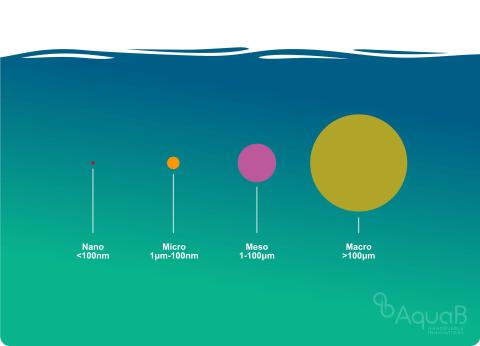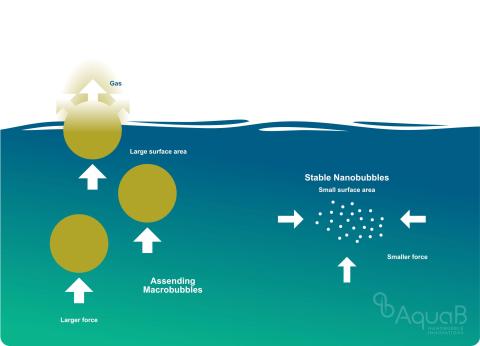A major and fundamental challenge is limited solubility in many liquids, e.g., gases, such as oxygen, and especially hydrogen, in water.
In ecosystems and the environment, lack of dissolved oxygen (DO) is a significant reason for fish kills and water bodies being blighted by algal blooms, in addition to sometimes lack of effectiveness concerning activated-sludge processes in water treatment or poorer-than-hoped results in irrigation.
At AquaB, we are commercialising novel water-gasification technologies based upon our breakthrough low-energy nanobubble (NB)-generation approaches. The company was set up in 2020 as a spin-out from Chemical Engineering at University College Dublin (UCD), to commercialise the patented platform NB-generation technology lead-invented by Company Director, inventor, chartered chemical engineer and industrialist Professor Niall English – who is also based at UCD Chemical Engineering, and holds an ERC Advanced grant on NBs with very broad applicability across several application areas. Since 2020-21, AquaB has been developing NB generators at TRL 4-8, aided by its European Innovation Council Accelerator Grant.
With record levels of fish-kills and blue-green algae infestations in water bodies, such as lakes, reservoirs, canals, rivers and estuaries in the past year or so (owing largely to excessive fertiliser usage in groundwater run-off from agriculture), and as global warming continues apace, we have seen the dramatic fall-out from low levels of DO: the fish die and cyanobacteria “take over”, meaning that the water is almost de-oxygenated and effectively “dead”. The resultant methane-rich stench emanating from the depths arises from a lack of oxygen – anaerobic conditions – deeper in the water.
Fully one-third of methane emissions to the atmosphere – perhaps 15-20 times worse for global-warming potential per tonne than CO2 – arise from under-aerated waterways. The levels of DO fall as the temperature rises – meaning that fish-kills are becoming all the more common now outside of high-summer with greater levels of warming.
This gas-solubility limit – in other words, the amount of gas (like oxygen) that can be accommodated naturally in water (or other liquids) – is known as “Henry’s Law”. For centuries, it has been taken for granted that there was no way to accommodate additional levels of gas in liquids beyond this “thermodynamic limit”, other than for very short times – at great energy and operational expense.
However, my lead-invention and development of energy efficient, membrane-free and additive-free methods to generate vast quantities of NBs in liquids, such as water, with long-lived nature to allow for the level of gas solubility to be increased meaningfully beyond the Henry’s-Law limit – could banish fish-kills to the past – and “breathe life back to water” – literally.
The Scale of Nanobubbles
NBs are tiny gas bubbles on the nanometre (nm) scale. They may be thermodynamically metastable for up to many months, or sometimes even longer, and have enhanced gas-transfer properties and substantial industrial potential. These NBs, shorter than the wavelength of light, are not visible to the naked eye, and are orders of magnitude smaller in dimension than the width of a human hair.

Electric Field Nanobubble Generation
AquaB’s method of generating NBs is based on static electric fields and electrostriction-based “sucking in” phenomena of gases into liquids – making “thick-skinned”, or ultra-dense, NBs with great mechanical strength and enhanced lifetime. After many industrial field trials in 2021-23, with further ongoing in 2024, it has been shown that these can deliver a step-change in the operational efficiencies of many industrial sectors.
When dissolved-gas levels are reduced, surface NBs tend to become smaller, albeit retaining their metastability, in stark contrast to thermodynamic predictions. In contrast, bulk NBs typically have 50–200 nm diameters, and their size can respond to ions and additives.
There is much industrial and ecological interest in the presence of bulk NBs, in that their occasional long life and stability, depending on their method of generation and bulk-liquid conditions, often exceed the residence time of many processes such as aeration cycles in activated-sludge tanks for wastewater treatment and recirculation-aeration systems or more broadly, for water-body aeration. This long life is particularly true for NBs generated via electrostriction.

Accelerating Environmental Sustainability
AquaB believes firmly that its commercially proven NB-generation technology will accelerate the company’s positioning in the marketplace for water management and treatment, with multiple customers and addressing UN Sustainable Development Goals (water, atmosphere) for the greater good of Man and the Earth’s environment.
With the current focus of governments, industry and research organisations around the world in a ‘race against time’ to implement the Paris Accord and tackle the degradation of the Earth’s environment and climate, a disruptive new technology with excellent energy, environmental and economic sustainability is needed for both water and the atmosphere.
Europe’s recent and well-placed leadership in the world-leading ‘Green Deal’ initiative shows how there can be – and should be – no conflict between economic growth and environmental/ climate progress. This calls for disruptive new green technologies as the world faces unprecedented turbulence and economic crisis in the 2020s, with population growth putting massive pressure on freshwater resources. Never has the need for environmental sustainability and water treatment been so critical – never has there been such a need for NBs.

